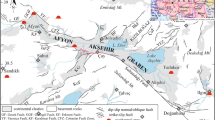Abstract
Based on the results of 15 years of research on the physical and chemical parameters of 11 occurrences of thermal and mineral water in the extended area of the spa town of Vrnjačka Banja, diverse hydrochemical types of water have been identified, originating from different lithological formations (serpentinite, schist, marble, etc.). Currently, the total amount of abstracted thermo-mineral water is close to 70 L/s, with water temperatures up to 33.8 °C. However, interpretation of collected data indicates that the chemical composition of the mineral water is not exclusively related to the mineralogical composition of the host rock, i.e., aquifer material. To better understand the genesis of these waters, multivariate statistical analysis was undertaken in combination with hydrochemical interpretation of different ionic ratios. This approach revealed the existence of three distinct clusters of thermal and mineral waters: (1) low temperature, low mineral content and mild alkaline; (2) slightly acidic, with a moderate mineral content and elevated iron and fluoride concentrations; and (3) thermal, rich in CO2, with elevated mineral content and iron, manganese and fluoride concentrations. Two primary hydrogeochemical processes, which influence the composition of the thermo-mineral waters, were also identified: dissolution of serpentinite rocks and dissolution of schists, both enhanced by the presence of CO2 gas, circulating through fault zones. Estimates of available geothermal energy suggest a significant potential for expanding current uses of thermal waters of this most popular spa center in Serbia.







Similar content being viewed by others
Notes
In Serbian, Banja denotes a spa town.
Groundwater source refers to a group of wells in the study area.
References
Anderson RD, Rubin H (1956) Statistical inference in factor analysis. In: Proceedings of the third Berkeley symposium of mathematical statistics and probability. pp 111–150
Appelo CAJ, Postma D (2005) Geochemistry, groundwater and pollution, 2nd edn. A. A. Balkema, Rotterdam
Bodansky D (1991) Appendix: energy units. In: Howes R, Fainberg A (eds) The energy source book. American Institute of Physics, New York
Box GEP, Cox DR (1964) An Analysis of Transformations. J R Stat Soc: Ser B (Methodological) 26(2):211–243
Davis JC (1986) Statistics and data analysis in geology. Wiley, New York
Dragišić V, Živanović V, Krmpotić M, Atanacković N, Tadić D, Nešković D, Magazinović S (2012) Hydrogeothermal resources of Vrnjačka Banja spa. In: Proceedings of 4th Spa International Congress, 15–16 May 2012, Vrnjačka Banja, Serbia. Serbian Spa society, Belgrade. pp 128–139 (in Serbian)
Güler C, Thyne GD, McCray JE, Turner AK (2002) Evaluation of graphical and multivariate statistical methods for classification of water chemistry data. Hydrogeol J 10:455–474
Helena BA, Vega M, Barrado E, Pardo R, Fernandez L (1999) A case of hydrochemical characterization of an alluvial aquifer influenced by human activities. Water Air Soil Pollut 112:365–387
Kaiser HF (1960) The application of electronic computers to factor analysis. Educ Psychol Measur 20:141–151
Lazić M, Kljajić Ž (2018) One hundred and fifty years of thermo-mineral water of Vrnjacka Banja. In: Book of abstracts of 17th Geological Congress of Serbia, 17–20 May 2018, Vrnjačka Banja, Serbia. Serbian Geological Society, Belgrade. pp 30–42 (in Serbian)
Leko MT, Ščerbakov A, Joksimović HM (1922) Medicinal waters and spas. Ministry of public health, Belgrade (in Serbian)
Marques JM, Carreira PM, Carvalho MR, Matias MJ, Goff FE, Basto MJ, Graça RC, Aires-Barros L, Rocha L (2008) Origins of high pH mineral waters from ultramafic rocks, Central Portugal. Appl Geochem 23:3278–3289
Massart DL, Kaufman L (1983) The interpretation of analytical chemical data by the use of cluster analysis. Wiley, New York
Nikolić J (2009) Study on natural mineral water reserves from Sž-1/79 well, at the Snežnik locality in Vrnjacka Banja spa. Hidrogeocentar d.o.o, Belgrade (in Serbian)
Official Gazette of the Republic of Serbia 43/2013 (2013) Regulations on quality and other requirements for natural mineral water, natural spring water and table water (in Serbian)
Stanković S (2010) Serbian spas. Textbooks Institute, Belgrade (in Serbian)
Stevanović SP (1939) Vrnjacka Banja—geological composition, origin, occurrence and chemical constitution of mineral waters. Dragoslav Gregorić Press, Belgrade (in Serbian)
Stevanović Z (2010) Utilization and regulation of springs. In: Krešić N, Stevanović Z (eds) Groundwater hydrology of springs—engineering, theory, management, and sustainability. Elsevier, The Netherlands, pp 339–388
Stumm W, Morgan JJ (1970) Aquatic chemistry—an introduction emphasizing chemical equilibria in natural waters. Wiley, New York
Sverdrup HU, Oelkers E, Lampa ME, Belyazid S, Kurz D, Akselsson C (2019) Reviews and synthesis: weathering of silicate minerals in soils and watersheds: parameterization of the weathering kinetics module in the profile and for safe models. Biogeosciences Discuss. doi: https://doi.org/10.5194/bg-2019-38
Urošević M, Pavlović Z, Klisić M, Malešević M, Stefanović M, Marković O, Trifunović S (1966) Basic geological map of the SFR Yugoslavia, Sheet Vrnjci 1:100000. Federal Geological Survey, Belgrade (in Serbian)
van der Aa M (2003) Classification of mineral water types and comparison with drinking water standards. Environ Geol 44:554–563
van Wirdum G (1991) Vegetation and hydrology of floating rich-fens. Datawyse, Maastricht
Ward JH (1963) Hierarchical grouping to optimize an objective function. J Am Stat Assoc 69:236–244
Acknowledgments
This article is the result of the Project III 43004 financed by the Ministry of Education, Science and Technological Development of the Republic of Serbia.
Author information
Authors and Affiliations
Corresponding author
Additional information
Publisher's Note
Springer Nature remains neutral with regard to jurisdictional claims in published maps and institutional affiliations.
Rights and permissions
About this article
Cite this article
Štrbački, J., Živanović, V., Ćuk Đurović, M. et al. Origin, diversity and geothermal potentiality of thermal and mineral waters in Vrnjačka Banja, Serbia. Environ Earth Sci 79, 309 (2020). https://doi.org/10.1007/s12665-020-09050-y
Received:
Accepted:
Published:
DOI: https://doi.org/10.1007/s12665-020-09050-y




